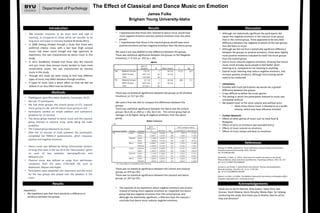
poster1
- 1. References • We consider emotions to be short term and high in intensity, as compared to mood which we consider to be long term and lower in intensity (Lamont & Eerola 2011). • In 2008 Delsing showed through a study that those who preferred intense music with a fast beat (high arousal music) had lower moral though and high openness to experience, this was characterized by dance music in this study. • In 2011 Gardikiotis showed that those who like classical and jazz music (low arousal music) tended to have more conservative values, this was characterized by classical music in this study. • Through this study we were trying to find how different types of music may affect behavior through emotion. • If types of music have a direct affect on how we feel we believe it can also affect how we behave. Introduction Methods Results • Participants were BYU-Idaho Students, Caucasians 18-25. • We had 57 participants. • We had three groups, the control group (n=17), classical music group (n=18), and the dance music group (n=22). • Participants worked on simple addition and subtraction problems for 15 minutes. • The dance group listened to dance music and the classical group listened to classical music while doing the math problems. • The Control group listened to no music. • After the 15 minutes of math problems the participants completed the PANAS-X questionnaire, which measures positive and negative emotions. • Dance music was defined by taking instrumental versions of songs that were in the top 30 in the “dance/party” genre on each of two websites: dancetop40.com and billboard.com. • Classical music was defined as songs from well-known composers from the years 1750-1830 AD, such as Beethoven, Mozart and Haydn. • Participants were separated into classrooms and the music for the two groups was played over the speakers in the room. Discussion The Effect of Classical and Dance Music on Emotion James Fulks Brigham Young University-Idaho Delsing, M. (2008), Adolescents’ music preferences and personality characteristics. European Journal of Personality, 22(2), 109-130. doi: 10.1002/per.665. Gardikiotis, A; Baltiz, A. (2011), ‘Rock music for myself and justice to the world!: Musical identity, values and musical preferences. Psychology of Music, 2012, 40, 143. doi: 10.1177/0305735610386836 Lamont,A. and Eerola, T. (2011) Music and emotion: Themes and development Musicae Scientiae, July 2011 vol. 15 no. 2 139-145; doi: 10.1177/1029864911403366 Watson, D; Clark, L.A (1994). The PANAS-X: Manual for the Positive and Negative Affect Schedule- Expanded Form. University of Iowa • I hypothesized that those who listened to dance music would have more negative emotions and less positive emotions than the other groups. • I hypothesized that those in the classical group would have more positive emotions and less negative emotions than the dance group. We used a one-way ANOVA to test difference between the groups. There was statistical significance between the groups on NA (Negative Emotions), F= 4.523, p= .015 (p < .05). There was no statistical significance between the groups on PA (Positive Emotions), p=.517 (p>.05). We used a Post Hoc test to compare the differences between the groups. There was statistical significance between the dance and the control groups. M=4.30, p=.004 (p < .05), SD=1.44. The control group had on average a 4.30 higher rating of negative emotions, than the dance group. There was no statistical significance between the control and classical groups, p=.076 (p>.05). There was no statistical significance between the classical and dance groups, p=.267 (p>.05). • The opposite of my hypothesis about negative emotions was proven. Instead of having more negative emotions as I expected, the dance group had less negative emotions than the control group, and although not statistically significant, a little less than the classical. I conclude that dance music reduces negative emotions. • Although not statistically significant the participants did report less negative emotions in the classical music group than in the control group. There appeared to be very little difference between the negative emotions of the two groups that did listen to music. • Although we did not find a statistically significant difference between the groups on positive emotions, there were slightly more positive emotions indicated for both the music groups than the control group. • Dance music reduced negative emotions, showing that dance music could actually cause people to feel better when listening to it, compared to not listening to anything. • Overall music listening may reduce negative emotions, and increase positive emotions, although more testing would need to be conducted. • Limitations: • Possibly with more participants we would see a greater difference between the groups. • It was difficult to define the music genres. • The setting in which the participants listened to music was somewhat artificial. • We played music at the same volume and without lyrics. • Many times Dance music is listened to at a louder volume, which may have influence emotion. • Further Research: • Effects of other genres of music such as Hard Rock & Bluegrass. • Effects of lyrics on emotions (we excluded lyrics). • Effects of music volume on emotions. • Effects of music tempo and beat on emotions. Hypothesis: • My hypothesis was that there would be a difference in emotions between the groups. Results Acknowledgements Thank you to Devin Marrott, Kelly Sutton, Taylor Ririe, Ben Duncan, Devin Malone, Kevin Murphy, Nikole Alyes for helping conducting the study. And thank you to Brother Gee for all his help and direction!